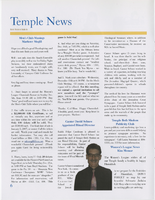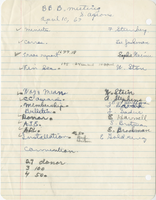Search the Special Collections and Archives Portal
Search Results

Dorothy Eisenberg interview, March 8, 2017: transcript
Date
Archival Collection
Description
Multicultural advancements in Las Vegas cannot be mentioned without speaking on the monumental contributions of Dorothy Eisenberg. From 1971 to 1998, she was involved with over 25 local organizations and committees and had the honor of having an elementary school named after her. Eisenberg’s beginnings start in the midst of the all American melting pot experience though immigration. Her mother came to the United States from Russia at age twelve and her father from Austria at age sixteen to go upholstery school. Upon marriage, they settled down in Philadelphia after the World War II. They raised Dorothy and her siblings to contribute to the community despite the anti-Semitism that was displayed there on a regular basis. Signs that said, “No dogs and Jews allowed” were common place. After her first husband died, leaving her as a single mother of four little girls, she didn’t allow herself to be trampled by her circumstances by enrolling in Temple University to be a teacher at a time when the university had stigma towards older students. Upon her marriage to her second husband, the family moved to Las Vegas where she found a spiritual home for her family at Temple Beth Sholom, where her children went learned to deeply appreciate their Jewish heritage and attended Hebrew school. Having always been involved with politics in Philadelphia, she faced personal discrimination due to her religion when she was searching for organizations to involve her time. She eventually found a home with the League of Women Voters in 1965 and became involved with the Observers Corp and became aware of what was going on with the African American community from community based research and dialogue. She played a key role as president of the organization and faced heat for her involvement in the desegregation of sixth grade centers with the Kelly vs. Guinn decision in 1972 and was involved with the Welfare Rights Movement. She met Ruby Duncan and Jane Fonda, and she even showed up to the march with her daughters. Eisenberg was heavily involved with her namesake school through meetings with principals at least once a year, reading to students in the classroom, and bringing latkes to the school on Hanukkah. She continues the intergenerational legacy of educational involvement set forth by her parents with supporting her children, grandchildren and great grandchildren in the school as well. Dorothy Eisenberg is a true role model for Nevada and a pioneer for equal education in Las Vegas.
Text
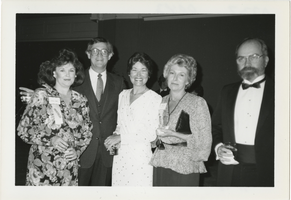
Photograph of Chris Hall, Judge John McGroarty and others at the WE CAN “Love Ya Child” benefit at the Union Plaza Hotel in Las Vegas, Nevada, 1984
Date
Description
Image
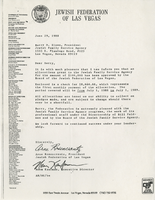
Jewish Federation correspondence, meeting minutes, and other records, item 20
Description
Letters to Barry D. Eisen, President of the Jewish Family Service Agency, and William Feldman, Executive Director of the Jewish Family Service Agency, about funding, June 1988.
Junior League of Las Vegas Records
Identifier
Abstract
The Junior League of Las Vegas Records (1940-2023) contain annual reports, fundraising information, training manuals, articles, minutes, photographs, scrapbooks, cookbooks, and other operational and working files that document the activities of the Junior League of Las Vegas (JLLV). Also included is documentation for advocacy projects the JLLV was involved with, such as Drug Abuse Resistance Education (D.A.R.E.), Safe Haven, the Ronald McDonald House, Read Aloud, and Literature Awareness Program for Children. Other records in this collection document JLLV's fundraising efforts such as the Repeat Boutique, Holiday Coffees, annual benefits, luncheons, and sales of their cookbooks. Also included are scrapbooks and issues of their newsletter
Archival Collection
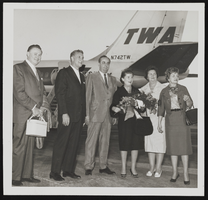
Photographs of Eva Adams, (Nev.) 1961-1966
Date
Archival Collection
Description
Image
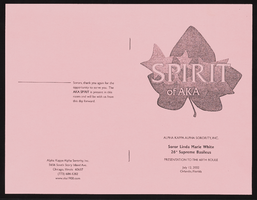
"Spirit of AKA" Alpha Kappa Alpha Sorority targets presentation summary
Date
Archival Collection
Description
This a brochure of the AKA Spirit program to celebrate the 60th Boule, including a presentation by 26th Supreme Basileus Soror Linda Marie White.
From the Alpha Kappa Alpha Sorority, Incorporated, Theta Theta Omega Chapter Records (MS-01014) -- Chapter records file.
Text
Christine Barrett oral history interview
Identifier
Abstract
Oral history interview with Christine Barrett conducted by Claytee D. White on March 19, 2021 for African Americans in Las Vegas: a Collaborative Oral History Project.
Christine Barrett talks of her educational background and previous employment history that led her from California to Massachusetts, Virginia, and California again before her final move to Las Vegas. She has worked in management positions related to Las Vegas Valley water use for 38 years, and in the past decade has begun working for the Clark County School District in various professional capacities.
Archival Collection
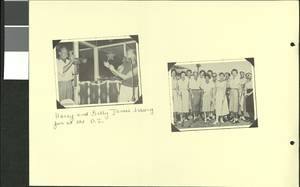
Desert Inn Country Club family album, page 26
Description
Two black and white photographs of people at the Desert Inn in Las Vegas, Nevada. The handwriting under the left image reads: "Harry and Betty James having fun at the D.I." The image on the right features a group of women holding golf clubs.

